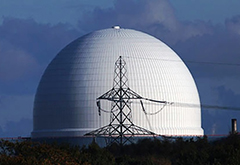Nuclear Power Plants
A nuclear power plant or nuclear power station is a thermal power station in which the heat source is a nuclear reactor. As it is typical of thermal power stations, heat is used to generate steam that drives a steam turbine connected to a generator that produces electricity. As of 23 April 2014, the IAEA report there are 449 nuclear power reactors in operation operating in 31 countries.
Nuclear plants are usually considered to be base load stations since fuel is a small part of the cost of production and because they cannot be easily or quickly dispatched. Their operations and maintenance (O&M) and fuel costs are, along with hydropower stations, at the low end of the spectrum and make them suitable as base-load power suppliers. The cost of spent fuel management, however, is somewhat uncertain.
The conversion to electrical energy takes place indirectly, as in conventional thermal power stations. The fission in a nuclear reactor heats the reactor coolant. The coolant may be water or gas or even liquid metal depending on the type of reactor. The reactor coolant then goes to a steam generator and heats water to produce steam. The pressurized steam is then usually fed to a multi-stage steam turbine. After the steam turbine has expanded and partially condensed the steam, the remaining vapour is condensed in a condenser. The condenser is a heat exchanger which is connected to a secondary side such as a river or a cooling tower. The water is then pumped back into the steam generator and the cycle begins again. The water-steam cycle corresponds to the Rankine cycle. More details
The conversion to electrical energy takes place indirectly, as in conventional thermal power stations. The fission in a nuclear reactor heats the reactor coolant. The coolant may be water or gas or even liquid metal depending on the type of reactor. The reactor coolant then goes to a steam generator and heats water to produce steam. The pressurized steam is then usually fed to a multi-stage steam turbine. After the steam turbine has expanded and partially condensed the steam, the remaining vapour is condensed in a condenser. The condenser is a heat exchanger which is connected to a secondary side such as a river or a cooling tower. The water is then pumped back into the steam generator and the cycle begins again. The water-steam cycle corresponds to the Rankine cycle. More details

